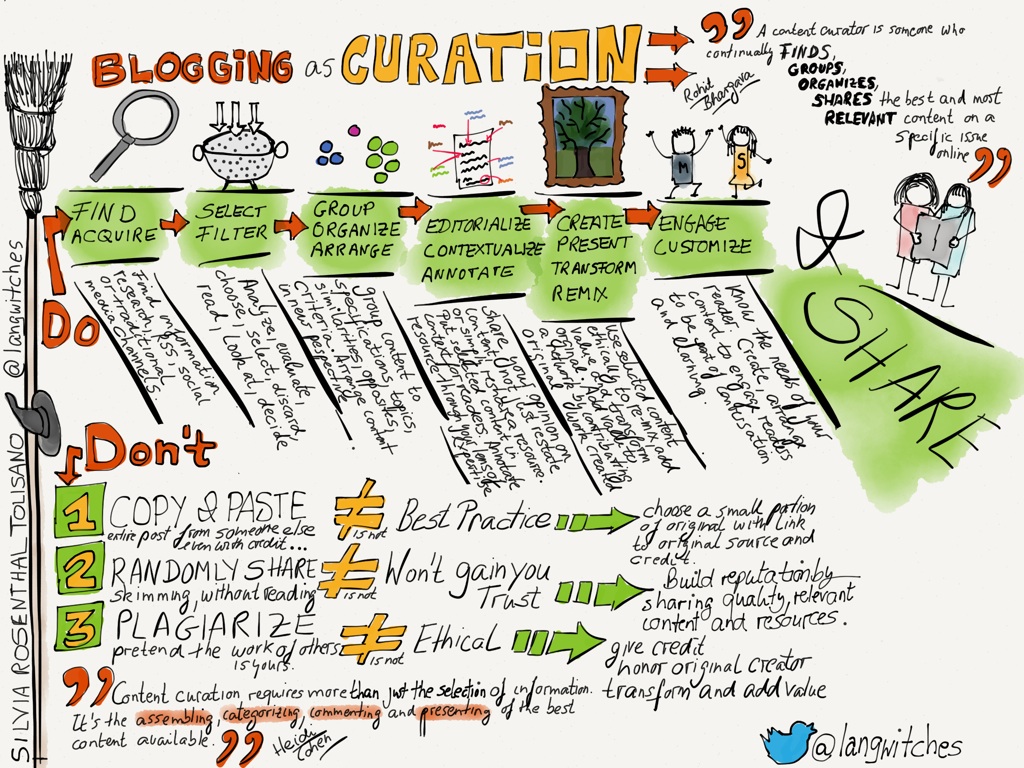Blogging as a Curation Platform

I have written about curation before using Twitter as a Curation Tool and about the importance of helping our Students Becoming Curators of Information. Sue Waters also just published a very comprehensive Curation: Creatively Filtering Content on her blog.
According to Heidi Cohen
Content curation requires more than just the selection of information. It’s the assembling, categorizing, commenting and presenting of the best content available.
I want to take a look at curation through the lens of blogging. How can educators and students use their blogs to become their own information curators and content curators for others in their learning community. Previously, I listed four uses for Twitter as a Curation Tool
Curator
Consciously becoming the curator for others for a particular niche, area of expertise or interest. Disseminate resources with added value, put in perspective, create connections, present in a different light/media/language.
This is the difference that separates the “collectors” from the “curators”. Establish yourself as an expert, by sharing selected quality information freely. This is when YOU become the trusted member of a network that funnels QUALITY / FILTERED information to others.
Information
Collecting, organizing, connecting, attributing, interpreting, summarizing the vast amount of information that comes across your desk/ feed /books/articles/etc. for YOURSELF!
Tools and ideas to transform education. Sign up below.
Network
Taking advantage of a network of curators working for you (building your own customized network), consuming their curated information.
In Real Time
Real time curation allows you to be part of an event, that you physically might not be attending or being on the opposite end allows you to be the bridge for others to participate at an event where you are present, but your network is not.
The same uses apply to blogging as a curation tool with the difference that blogging allows you greater freedom in terms of length, presentation formatting and design, as well as connecting and hyperlinking.
As a blogger, I have found the following workflow as a curator:
- Find & Acquire Find information, do research, use RSS, social or traditional media channels. I read mostly via RSS feeds and my Twitter Network
- Select & Filter Analyze, evaluate, choose, select, discrd, read, look at and decide…I read… I choose…I tweet…, I “pocket“…, I diigo…, I pin…
- Group, Organize & Arrange Group content to specifications, topics, similarities, opposites, specific criteria. Arrange content in a new light. Use tags and categories on blog, to group similar posts together I start a blog post in draft and add as I go along, as my train of thought moves, as a find more resources. I copy /paste and re-arrange quotes, links, etc.
- Editorialize, Contextualize & Annotate Share your opinion on content, not just restate or simple reshare a resource. Put selected content in context for readers. Annotate resource through your lens of expertise. I try to connect resources, add value with another perspective, through a different lens, I try to make what I think and see visible to others
- Create, Present, Transform & Remix Use selected content ethically to remix, add value and transform the original. Add value to your network by contributing original work. I try to create something new for every post: a mindmap, a sketchnote, an image, a slide deck, an infographic, a video, etc.
- Engage & Customize Know the needs of your readers. Create and arrange your content to engage readers to be part of the conversation and learning. Although my blog is primarily a platform for my own writing, learning, organizing, archiving and processing of information, I do write with an audience in mind: educators. I try to engage readers to contribute, add value and connect their own learning as part of a crowdsourced effort of redefining learning and teaching.
- Share I believe in Sharing and Amplification Ripple Effect
Some Don’ts for Curators:
- Don’t simply copy and paste entire articles from other sites with the intent of “collecting” interesting and relevant work from many different sources in one place. It is not considered best practice among the blogging community. A better way would be to choose a relevant, short portion (quote) of the original work and link to the original author and blog to encourage readers to click in order to read more.
Rohit Bhargava reminds us that
a content curator is someone who continually finds, groups, organizes, shares the best and most relevant content on a specific issue online
I constantly rely on specific curators for certain topics or issues in my network to feed me quality and RELIABLE information.
- Don’t randomly sharing a large amount of links in a rapid fire sequence or in a looong bulleted list of links -it's collecting, not curating. Most of the time, it is seems that “link collectors” just skim over the titles and at most a few sentences of the resources without reading, nor digging deeper into the content. It is by sharing quality and relevant content and by adding value to make me see connections, new background information or a different perspective I had not considered, that curators will gain my trust.
How do you use your blog as a curation tool? What is your niche? How do you become a trusted curator for your area of expertise in your learning network?
cross posted at langwitches.org/blog
Silvia Tolisano is a Curriculum21 faculty member, author of the book Digital Storytelling Tools for Educators and founder of the Around the World with 80 Schools project. Read more at http://langwitches.org/blog.
